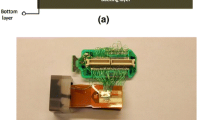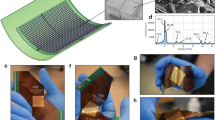Medical ultrasonic diagnostic apparatus have been used as a noninvasivemethod for diagnosing the human body since the 1970s. Figure 8.1 shows various types of commercialized medical pulse-echo ultrasound probes: (1) cardiac probe, (2) abdomen probe, and (3) high-frequency linear probe for diagnostic applications.
The medical ultrasonic array probe consists of four basic materials: backing, piezoelectric, acoustic matching layers, and acoustic lens. A piezoelectric material such as lead zirconate titanate (PZT) or relaxor single crystals is the only active material used for the transducer, which transmits and receives ultrasound. On the other hand, acoustic matching layers are installed on the transducer in order to raise the transmission efficiency of the ultrasound, because the acoustic impedance (Z), which is expressed as sound velocity (c) × density(ρ), of PZT ceramic and that of human tissue are mismatched otherwise;i.e., ZPZT = 35×106 kg/m2s vs. Ztissue = 1.55×106 kg/m2 s. In general, the ultrasound is re-flected at the boundary with different Z.
Moreover, a convex-shaped acoustic lens is attached on top of the acoustic matching layers to focus the ultrasound beam and to ensure good contact to the human body. Specifically, the acoustic lens is used for focusing of the short axis; the elevation dimension determines the effective slice thickness of the image plane. The ultrasound transmission is attenuated in acoustic matching layers, acoustic lens, and human tissue. The acoustic attenuation (α) of the acoustic lens is very important because it is usually thicker than the matching layers.Moreover, α becomes large with increasing frequency; the α of the acoustic lens has a great effect on the sensitivity of a medical ultrasonic probe as well.
Access this chapter
Tax calculation will be finalised at checkout
Purchases are for personal use only
Preview
Unable to display preview. Download preview PDF.
Similar content being viewed by others
References
Fujii H, Nakaya C, Takeuchi H, Kondo T, Ishikawa Y (1995) Acoustic properties of lens materials for ultrasonic probes. Jpn. J. Appl. Phys. 34:312-315.
Grewe MG, Gururaja TR, Shrout TT, Newnham RE (1990) Acoustic properties of particle/polymer composites for ultrasonic transducer backing application. IEEE Trans. Ultrason. Ferroelect. Freq. Contr. 37:506-514.
Hayasaka T, Hayasaka H, Hosaka H (1994) Acoustic lens for medical diagnostic equipment. Japanese Published Patent Application No: H08-00615.
Hosono Y, Yamashita Y, Itsumi K (2007) Effects of metal oxide particle dopant on the acoustic properties of silicone rubber lens for medical echo probe. IEEE Trans. Ultrason. Ferroelectrics Freq. Contr. 54 (8):1589-1595.
Iinuma K, Hashiguchi M (1974) Ultrasonic transducer with silicone rubber lens. Jpn. J. Med. Ultrason. 28 (Suppl. 26):119-120 [in Japanese].
Iinuma K, Hashiguchi M (1978) Ultrasonic transducer with silicone rubber lens, Japanese Patent No. 1,191,390.
Irioka K, Tokunaga I, Fujii K (2000) Ultrasonic probe. Published Japanese Patent Application No. 2000-189417.
Kawabuchi M, Matsuo K, Muramatsu M, Fukumoto A, Saito K (1987) Ultrasonic transducer as-sembly for medical diagnostic examinations. United States Patent Application No. 4,699,150. 8 Low-Attenuation Acoustic Silicone Lens for Medical Ultrasonic Array Probes177
Kikuchi K (1979) Control of sound velocity in RTV silicone rubber by compounding various pow-ders. Nihon Onkyou Gakkaishi 35:29-35 [in Japanese].
Kossoff G (1979) Analysis of focusing action of spherically curved transducers. Ultrasound Med. Biol. 5:359-365.
Matsuo K (1989) Ultrasonic probe lens. Japanese Patent No. 1,551,320.
McKeighen RE (1998) Design guideline for medical ultrasonic array. Proc. SPIE, 3341:2-18.
Saito K, Fukase K (2002) Ultrasonic diagnostic apparatus, probe acoustic lens and their production method. Published Japanese Patent Application No. 2002-95081
Sato M, Shimamoto N (1996) Acoustic lens composition. Japanese Patent No. 3,105,151.
Shimamoto N, Handa R (1993) Acoustic lens composition. Japanese Patent No. 1,799,240.
Solomon RJ, Vogel GG, King R.W, Williams S (1996) Interface element for medical ultrasound transducer. United States Patent No. 5,505,205.
Yamashita Y, Hosono Y, Itsumi K (2005) Effects of metal particle dopant on acoustic attenuation properties of silicone rubber lens for medical echo array probe. Jpn. J. Appl. Phys. 44:4558-4560.
Yamashita Y, Hosono Y, Itsumi K (2006) Effects of sub-100 nm platinum metal particle on the acoustic attenuation properties of silicone rubber lens for medical array probe. Jpn. J. Appl. Phys. 45:4684-4686.
Yamashita Y, Hosono Y, Itsumi K (2007) Effects of ceramic nanopowder dopants on the acoustic properties of silicone rubber lens for medical echo probe. Jpn. J. Appl. Phys. 46:4784-4789.
Author information
Authors and Affiliations
Editor information
Editors and Affiliations
Rights and permissions
Copyright information
© 2008 Springer Science+Business Media, LLC
About this chapter
Cite this chapter
Yamashita, Y., Hosono, Y., Itsumi, K. (2008). Low-Attenuation Acoustic Silicone Lens for Medical Ultrasonic Array Probes. In: Safari, A., Akdoğan, E.K. (eds) Piezoelectric and Acoustic Materials for Transducer Applications. Springer, Boston, MA. https://doi.org/10.1007/978-0-387-76540-2_8
Download citation
DOI: https://doi.org/10.1007/978-0-387-76540-2_8
Publisher Name: Springer, Boston, MA
Print ISBN: 978-0-387-76538-9
Online ISBN: 978-0-387-76540-2
eBook Packages: EngineeringEngineering (R0)




